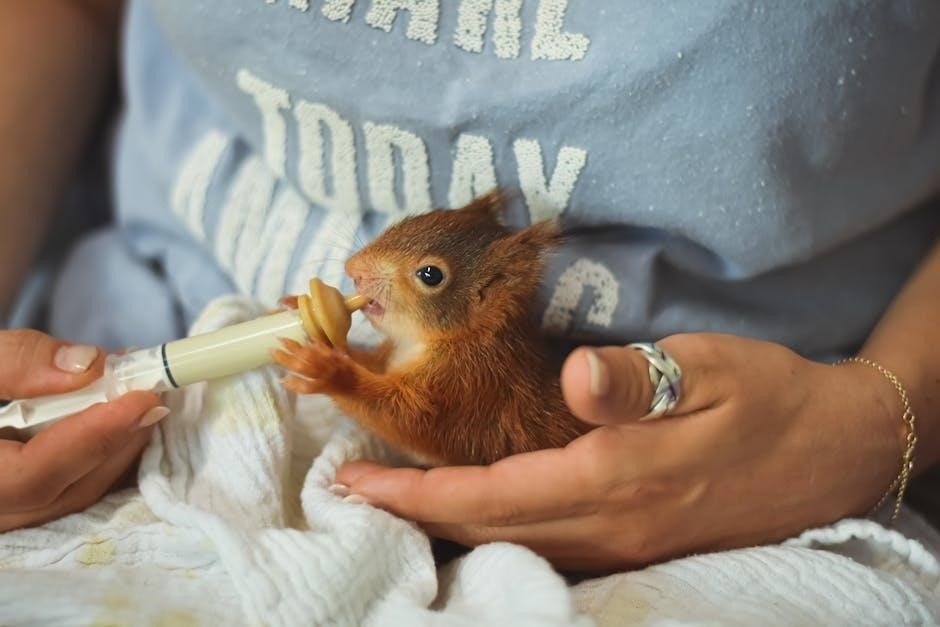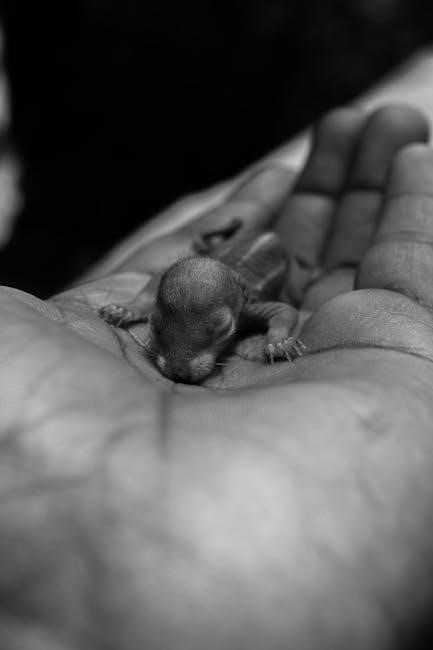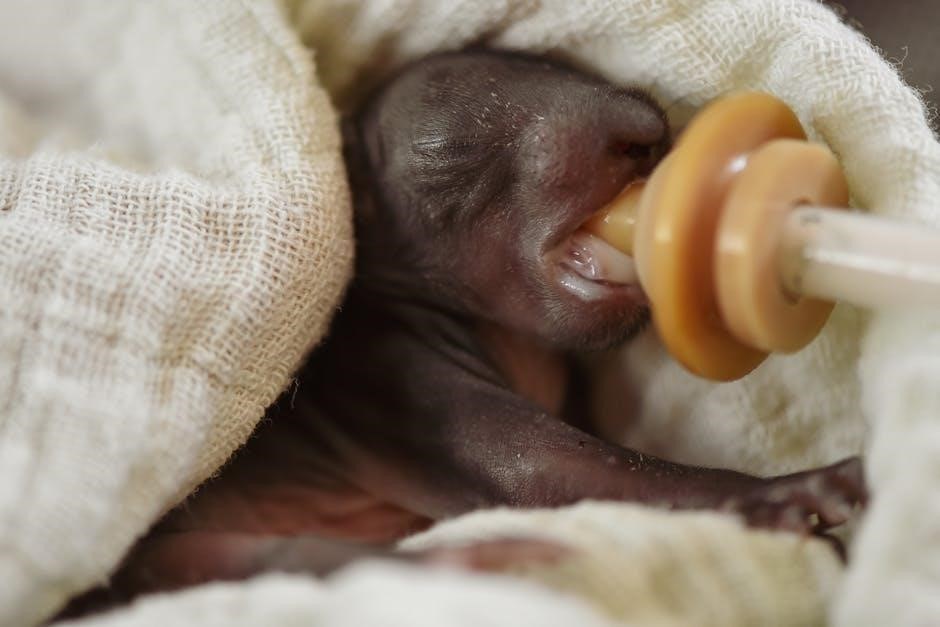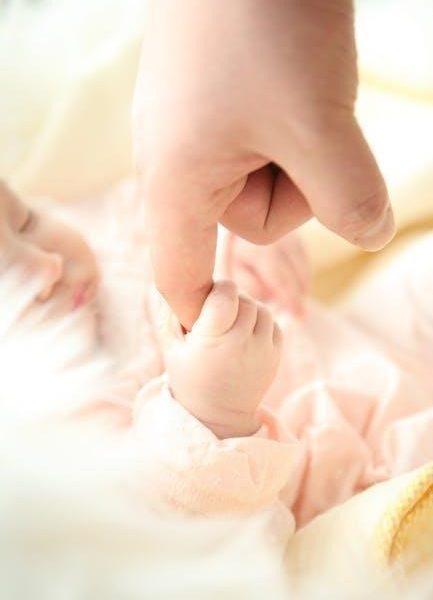Raising a baby squirrel requires dedication‚ proper handling‚ and a deep understanding of their specific needs. This guide provides essential steps to ensure their survival and well-being‚ focusing on nutrition‚ environment‚ and health. With the right care‚ you can help a baby squirrel thrive until it’s ready for life in the wild. Always prioritize professional advice from licensed wildlife rehabilitators for the best outcomes.

1.1 Why Proper Care is Essential

Proper care is vital for baby squirrels‚ as they are highly vulnerable and dependent on external support for survival. Without adequate nutrition‚ hydration‚ and a safe environment‚ they can quickly succumb to dehydration‚ malnutrition‚ or other health issues. Improper handling or neglect can lead to long-term developmental problems or even death. Baby squirrels rely entirely on caregivers to mimic the nurturing they would receive from their mother‚ making it crucial to follow expert guidelines. Incorrect care‚ such as feeding the wrong formula or failing to maintain proper warmth‚ can have devastating consequences. Proper care ensures they thrive and grow into healthy‚ independent animals.
1.2 When to Intervene and When Not To
Intervening in a baby squirrel’s life is crucial when they show signs of distress‚ such as falling from a nest‚ visible injuries‚ or being cold to the touch. If the mother is deceased or the baby is alone for an extended period‚ intervention is necessary. However‚ if the baby appears healthy and the mother is nearby‚ it’s best not to interfere. Unnecessary handling can stress the baby and reduce its chances of survival. Always check for the mother’s presence before deciding to care for the baby‚ as she is the best provider for her young.

Recognizing the Need for Care
A baby squirrel may need care if it exhibits signs like high-pitched squeaks‚ visible injuries‚ or being cold to the touch. Always assess its condition thoroughly.
2.1 Signs a Baby Squirrel Needs Help
A baby squirrel may need assistance if it appears cold‚ injured‚ or orphaned. Signs include high-pitched squeaking‚ visible injuries‚ or being alone without its mother. If it’s unresponsive‚ lethargic‚ or has discharge from the eyes or nose‚ immediate care is crucial. Additionally‚ if it’s dehydrated (e.g.‚ dry mouth or sunken eyes) or has parasites like fleas or mites‚ intervention is necessary. Always check for these signs before deciding to care for the squirrel‚ as early detection improves survival chances.
2.2 Common Scenarios for Intervention
Common scenarios requiring intervention include finding an orphaned or injured baby squirrel‚ often due to falls from nests during storms or accidental separation from their mother. If a baby squirrel is visibly injured‚ bleeding‚ or shows signs of distress‚ immediate care is needed. Additionally‚ if a squirrel is found alone‚ cold‚ or unresponsive‚ intervention is crucial. Another scenario involves visible parasites like fleas or mites‚ which can harm the squirrel’s health. Always assess the situation thoroughly before deciding to intervene‚ ensuring the best chance of survival for the baby squirrel.

Preparing the Environment
Create a safe‚ warm space using a plastic box or basket. Place a heat source‚ like a sock filled with rice‚ on one side for temperature regulation. Ensure proper ventilation to maintain a healthy environment for the baby squirrel.
3.1 Housing and Safety Measures
Provide a safe‚ escape-proof enclosure‚ such as a plastic box or basket‚ with proper ventilation. Line it with soft materials like towels or fleece. Ensure the baby squirrel cannot climb out or get trapped. Place a heat source‚ like a warm sock filled with rice‚ on one side for temperature regulation. Keep the environment clean to prevent health risks. Avoid hazards like loose threads or small gaps. Monitor the setup regularly to ensure safety and comfort. This secure space helps the baby squirrel feel protected and thrive during its early stages of development.
3.2 Maintaining Proper Temperature
Maintaining the right temperature is crucial for a baby squirrel’s health. Use a warm sock filled with rice or birdseed‚ heated in the microwave for 30 seconds‚ as a heat source. Place it on one side of the enclosure to allow the squirrel to regulate its body temperature. Ensure the environment stays slightly warmer than human body temperature‚ around 90-100°F for newborns. Monitor temperature closely to prevent overheating. As the squirrel grows‚ gradually reduce heat. Always use a thermometer to verify safety and comfort. Proper temperature control is essential for the baby squirrel’s survival and development.

Feeding the Baby Squirrel
Start with unflavored Pedialyte for hydration‚ then gradually introduce a nutrient-rich formula. Use a small syringe to feed‚ ensuring proper nutrition for growth and development.
4.1 Initial Hydration with Pedialyte
Initial hydration is crucial for a dehydrated baby squirrel. Use unflavored Pedialyte‚ administered via a small syringe to mimic natural feeding. Gently drop small amounts onto the tongue‚ allowing the squirrel to swallow. Avoid overhydration by monitoring the squirrel’s response. This step ensures the baby receives essential electrolytes before introducing formula. Proper hydration supports overall health and prepares the squirrel for subsequent feeding stages. Always handle with care to prevent stress and ensure the squirrel’s comfort during this critical phase.
4.2 Introducing Nutrient-Rich Formula
After initial hydration with Pedialyte‚ gradually introduce a nutrient-rich formula‚ such as a puppy milk replacer‚ to provide essential proteins and fats. Feed small amounts every 2-3 hours‚ using a syringe to mimic natural sucking. Start with diluted formula and gradually increase strength as the squirrel grows. Monitor for proper digestion and weight gain. Avoid overfeeding‚ as this can lead to health issues. Ensure the formula is at room temperature to prevent digestive upset. This step is vital for the baby squirrel’s growth and development‚ preparing it for the transition to solid foods later in its care journey.
4.3 Transitioning to Solid Foods
Transitioning to solid foods begins around 8-10 weeks of age. Start by offering soft‚ nutrient-rich foods like minced fruits‚ nuts‚ and a high-quality commercial rodent diet. Place these near the squirrel’s mouth to encourage exploration. Gradually mix solids with formula to ease the shift. Monitor the squirrel’s eating habits and weight to ensure proper nutrition. Avoid overfeeding to prevent obesity. Provide fresh water and a variety of textures to stimulate natural foraging behaviors. This phase is critical for developing essential survival skills and preparing the squirrel for independence. Always observe and adjust the diet based on the squirrel’s response and growth.
Hygiene and Grooming
Maintaining hygiene is crucial for a baby squirrel’s health. Clean their environment regularly and gently remove dirt with a soft cloth. Ensure proper handling to prevent stress.
5.1 Cleaning the Baby Squirrel
Cleaning a baby squirrel involves gently removing dirt and debris without causing stress. Use a soft‚ damp cloth to wipe their fur‚ paying attention to areas around the eyes and nose. Avoid submerging them in water‚ as this can cause hypothermia. For older squirrels‚ a shallow dish of warm water may encourage self-grooming. Always inspect for fleas‚ mites‚ or ticks‚ and use safe‚ specifically designed products for removal. Regular cleaning helps prevent parasites and maintains their overall health and comfort during care.
5.2 Managing Fleas‚ Mites‚ and Ticks
Regular inspections are crucial to detect and manage fleas‚ mites‚ and ticks on baby squirrels. Use a flea comb or tweezers to gently remove parasites. For severe infestations‚ use products specifically designed for small animals‚ ensuring they are safe for baby squirrels. Avoid harsh chemicals‚ as they can harm the squirrel. After removal‚ clean the area with a mild soap and water. Regular grooming and a clean environment help prevent re-infestation. Always check for signs of discomfort or illness‚ as parasites can cause significant health issues if left untreated.
Health Monitoring
Monitor the baby squirrel’s health daily for signs of illness‚ such as lethargy‚ labored breathing‚ or skin issues. Ensure proper hydration and nutrition‚ and watch for weight loss or gain. Regularly check for dehydration by gently pinching the skin; it should spring back quickly. Any unusual behavior or physical changes warrant immediate veterinary attention to prevent complications and ensure the squirrel’s well-being.
6.1 Recognizing Signs of Illness
Monitor for signs of illness‚ such as lethargy‚ labored breathing‚ or skin lesions. Dehydration is common‚ indicated by dry mouth or sunken eyes. Watch for parasites like fleas or mites‚ which can cause excessive scratching or hair loss. Respiratory issues may appear as sneezing or nasal discharge. Behavioral changes‚ such as refusal to eat or unusual vocalization‚ signal distress. Regularly check for weight loss or gain‚ as this can indicate malnutrition or underlying health problems. Immediate action is crucial to address these issues and prevent complications‚ ensuring the baby squirrel’s recovery and overall well-being.
6.2 Managing Dehydration and Malnutrition
Dehydration and malnutrition are critical issues in baby squirrels. Start with unflavored Pedialyte for hydration‚ administered via a small syringe. Gradually introduce a nutrient-rich formula to prevent malnutrition. Monitor for improvements in energy and weight. Severe cases may require a wildlife rehabilitator’s expertise. Ensure consistent feeding schedules and a balanced diet to support growth. Neglecting these conditions can lead to irreversible damage or death. Prompt intervention and proper care are vital to restore the baby squirrel’s health and ensure a successful recovery.
Socialization and Rehabilitation
Socialization is key for baby squirrels to develop natural behaviors. Handle gently to avoid imprinting‚ and introduce them to other squirrels if possible. Gradual exposure to outdoor environments helps prepare them for release‚ ensuring they adapt to wild instincts and survival skills. Proper rehabilitation requires patience and a safe‚ stimulating space to foster independence. A licensed wildlife rehabilitator can provide expert guidance for successful reintegration into nature.
7.1 Importance of Social Interaction
Social interaction is crucial for baby squirrels to develop normal behaviors and instincts. Handling them gently but minimally helps prevent imprinting‚ ensuring they remain wild. Introducing them to other squirrels fosters natural communication and play‚ essential for their emotional and physical growth. Proper socialization prepares them for independence and survival in the wild. Avoiding excessive human interaction prevents dependence‚ while encouraging environmental exploration builds their adaptability. A balanced approach to socialization ensures they thrive both in captivity and upon release‚ making it a cornerstone of successful rehabilitation.
7.2 Preparing for Release into the Wild
Preparing a baby squirrel for release involves gradual acclimation to outdoor conditions. Start by introducing them to a secure‚ escape-proof enclosure with natural elements like branches and leaves. Encourage foraging by hiding food‚ promoting their natural instincts. Ensure they can climb and exhibit wild behaviors before release. Monitor their ability to avoid predators and interact normally. Release should occur in a safe‚ squirrel-friendly area near where they were found. Consult a wildlife rehabilitator to determine the optimal time and location‚ ensuring the best chance of survival in their natural habitat.
Emergency Care and Support
In emergencies‚ contact a licensed wildlife rehabilitator immediately. For squirrel emergencies‚ call 269-215-9509 for real-time advice. Ensure the baby is warm‚ hydrated‚ and safe until professional help arrives.
Always prioritize expert care for critical situations.
8.1 First Aid for Injuries
For injured baby squirrels‚ handle them gently with gloves to avoid transferring your scent. Place them in a warm‚ quiet space to reduce stress. If bleeding‚ apply gentle pressure with a clean cloth. Never administer painkillers‚ as they can be harmful. Hydrate with unflavored Pedialyte using a syringe. For fractures‚ immobilize the area with a splint. Avoid home remedies and seek immediate professional care. Contact a licensed wildlife rehabilitator or call 269-215-9509 for emergency assistance. Proper first aid ensures the best chance of recovery before transferring to expert care.
8.2 Contacting Wildlife Rehabilitators
Contacting a licensed wildlife rehabilitator is crucial for the best care of injured or orphaned baby squirrels. They have the expertise to address specific needs and ensure proper treatment. For emergency assistance‚ call 269-215-9509 or visit local wildlife rehabilitation centers. Improper care can lead to long-term harm or even death. Rehabilitators provide specialized feeding‚ medical care‚ and socialization. Always prioritize professional help over home care for the best outcomes. Find certified rehabbers through local wildlife organizations or online directories to ensure your baby squirrel receives the care it deserves for a successful return to the wild.



